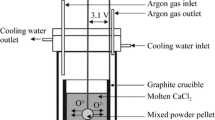Abstract
As an important powder material for scandate cathode, Sc2O3-doped WO3 powder together with hollow spherical WO3 for comparison was prepared by spray-drying method. The reduction behavior and kinetics of pure WO3 and Sc2O3-doped WO3 were studied by temperature-programmed reduction (TPR) method. It is found that scandia doping can decrease the reduction activation energy of WO3 and thus lower the reduction temperature and increase the reduction rate. Based on the kinetics results, the reduction techniques are presented. The obtained powder has a narrow size distribution in the range of 0.6–0.8 μm.







Similar content being viewed by others
References
Ginson JW, Hass GA, Thomas RE. Investigation of scandate cathodes: emission, fabrication. and activation processes. IEEE Trans Electron Devices. 1989;36(1):209.
Wang JS, Yang YF, Wang YM, Liu W, Zhou ML. A review on scandia doped tungsten matrix scandate cathode. Rare Met. 2019;1(1):91.
Qi JB, Ru LL, Wu GX, Zhang JY, Chou KC. First principles application for mechanical properties of Ti-doped W particles enhanced U matrix composite. Rare Met. 2018;37(9):815.
Yang Y, Wang YM, Liu W, Pan ZL, Li JH, Wang JS. Robustness investigation on nanosized-scandia-doped dispenser cathodes. IEEE Trans Electron Devices. 2018;65(6):2072.
Xu Q, Liu FS. Transformation behavior and shape memory effect of Ti50-xNi48Fe2Nbx alloys by aging treatment. Rare Met. 2012;31(4):311.
Kapustina VI, Lia IP, Shumanova AV, Lebedinskiib Y, Zablotskiib AV. Physical operating principles of scandate cathodes for microwave devices. Phys Electrons. 2017;62(1):116.
Wang JS, Lai C, Zhang X. Effect of scandia doping method on the emission uniformity of scandate cathode with Sc2O3–W matrix. Mater Res Bull. 2013;9(48):3594.
Wang YM, Wang JS, Liu W, Zhang K, Li J. Development of high current-density cathodes with scandia-doped tungsten powders. IEEE Trans Electron Devices. 2007;54(5):1061.
Liu X, Vancil BK, Beck MJ, Balk TJ. Near-surface material phases and microstructure of scandate cathodes. Materials. 2019;12(4):636.
Liang WL, Wang YM, Wang JS. DC emission characteristic of nanosized-scandia-doped impregnated dispenser cathodes. IEEE Trans Electron Devices. 2014;61(6):1749.
Zhao JF, Gamiza D, Li N, Li J, Spear AG, Luhmann N. Scandate dispenser cathode fabrication for a high-aspect-ratio high-current-density sheet beam electron gun. IEEE Trans. Electron Devices. 2012;59(6):1792.
Vancil B, Lorr J, Brodie I, Schmicht V. Scandate dispenser cathodes with sharp transition and their application in microwave tubes. IEEE Trans Electron Devices. 2014;61(6):1754.
Kirkwood DM, Gross SJ, Balk TJ. Frontiers in thermionic cathode research. IEEE Trans Electron Devices. 2018;65(6):2061.
Sunil Kumar P, Jayasankar K, Ranjan B. Development of high density tungsten based scandate by spark plasma sintering for the application in microwave tube devices. Int J Refract Met Hard Mater. 2016;61:215.
Zhang XZ, Wang JS, Liu W. Preparation of W–Sc2O3 targets and scandate cathodes with film prepared by pulsed laser deposition. Mater Res Bull. 2013;12(48):5040.
Jacobs R, Morgan D, Booske J. Work function and surface stability of tungste-based thermionic electron emission cathodes. APL Mater. 2017;5:116105.
Wang JS, Cui YT, Liu W, Wang YM, Yang F, Zhou F, Zhou ML. A study of scandia-doped-impregnated cathode fabricated by spray drying method. IEEE Trans Electron Devices. 2015;62(5):1635.
Lai C, Wang JS, Zhou F. Preparation and surface characteristics of Re3W matrix scandate cathode: an experimental and theoretical study. Appl Surf Sci. 2018;440:763.
Yang F, Wang JS, Wang YM. Investigation of nanosized-scandia-doped dispenser cathodes with machined surfaces. IEEE Trans Electron Devices. 2016;63(4):1728.
Mroz MV, Kordesch ME, Sadowski JT. Scandium function in “scandate” thermionic cathodes: a microspot synchrotron radiation X-ray photoelectron spectroscopy study of co-adsorbed Ba-Sc-O on W. J Vacuum Sci Technol A: Vacuum, Surf, Film. 2019;37(3):030602.
Wang JS, Tian T, Liu W. Emission property and microstructure of Re doped cathode. J Beijing Polytech Univ. 2015;41(04):481.
Lai C, Wang JS, Zhou F. The adsorption and diffusion properties of scandium atom on the surfaces of tungsten and noble metals. Appl Surf Sci. 2018;457(1):1057.
Hasker J, Crombeen JE, Dorst P AM. Comment on progress in scandate cathodes. IEEE Trans Electron Devices. 1989;36(1):215.
Yuan HQ, Gu X, Pan KX, Wang YM, Liu W, Zhang K, Wang JS, Zhou ML, Li J. Characteristics of scandate-impregnated cathodes with sub-micron scandia-doped matrices. Appl Surf Sci. 2005;251(1–4):106.
Vancil B, Olinger VL, Green MC. New findings on powder synthesis for scandate cathode matrices. IEEE Trans Electron Devices. 2018;65(6):2077.
Wang JS, Lu H, Liu W, Wang YC, Li L, Zhou ML. A study of scandia doped tungsten nano-powders. J Rare Earths. 2007;25(2):194.
Editing Committee of a Manual of Rare Metal. A Manual of Rare Metal. Beijing: Metallurgical Industry Press; 1995. 447.
Lassner E, Schubert WD. Tungsten: Properties, Chemistry, Technology of the Element, Alloys, and Chemical Compounds. Berlin: Springer; 1999. 145.
Hurst NW, Gentry SJ, Jones A, McNicol BD. Temperature programmed reduction. Catal Rev. 1982;24(2):233.
Xu Y, Wang R. Study of reduction kinetics of oxide system. Chem Eng Natural Gas. 1994;19:20.
Acknowledgements
This work was financially supported by the National Key Research and Development Program of China (Nos. 2017YFA0701000 and 2016YFE0126900), the National Natural Science Foundation of China (Nos. 51471006, 51534009 and 52621003) and the Fundamental Research Funds for the Central Universities (Nos. ZYGX2018J024 and ZYGX2015Z010).
Author information
Authors and Affiliations
Corresponding author
Rights and permissions
About this article
Cite this article
Wang, JS., Zhao, Q., Liu, T. et al. Reduction behavior of tungsten oxide with and without scandia doping. Rare Met. 40, 687–692 (2021). https://doi.org/10.1007/s12598-019-01367-3
Received:
Revised:
Accepted:
Published:
Issue Date:
DOI: https://doi.org/10.1007/s12598-019-01367-3




